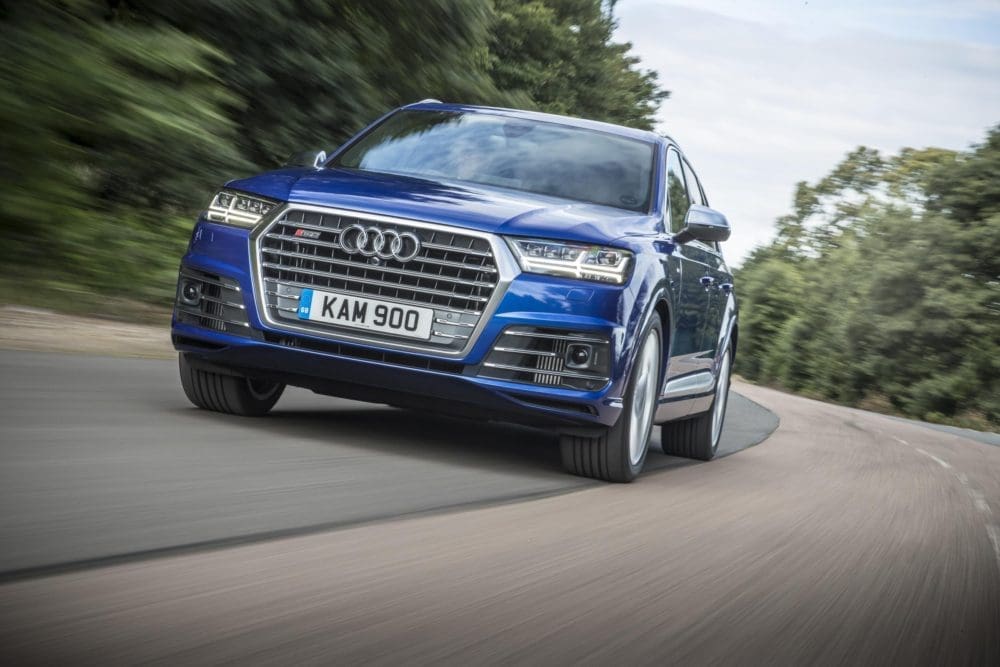



There is also a powerful new 48-volt electrical subsystem which makes its Audi debut in the Q7 and the company says this will be the springboard for numerous revolutionary new technologies in the Audi models of the near future.
As it is electrically driven and therefore not dependent upon exhaust flow like conventional turbochargers, the EPC brings its force to bear on the 4.0-litre, eight-cylinder TDI in less than 250 milliseconds. Whenever the exhaust gases provide sufficient energy two sequentially activated ‘conventional’ turbochargers take over.
Now developing 429 bhp and 663.8 lb ft of torque, the redesigned V8 BiTDI stakes Audi’s claim to offer the most powerful diesel SUV on the market. The SQ7 achieves a 0-62mph sprint time of just 4.9 seconds. Top speed is limited to 155mph, and in the New European Driving Cycle (NEDC), the SQ7 TDI returns up to 39.2 mpg combined. This corresponds to CO2 emissions of 190 g/km.
The exhaust, which each cylinder discharges from both exhaust valves, flows through separate channels within a dual-flow manifold system. Each exhaust valve supplies one of the two sequentially activated turbochargers. The Audi valvelift system (AVS), which makes its debut in a TDI engine in the SQ7 TDI, keeps one valve closed at low and intermediate load and rpm so that the entire exhaust flow reaches the so-called “active” turbocharger. If engine speed increases to the range between 2,200 and 2,700 rpm, the respective second exhaust valve is opened and the second turbocharger is also activated.


In conjunction with the EPC, the 48-volt electrical subsystem also paves the way for incorporation of an electromechanical active roll stabilisation system. Here, a compact electric motor with a three-stage planetary gearbox separates the two halves of the stabiliser. On an uneven road surface, they are actively decoupled from one another, resulting in improved ride comfort, but during faster driving they are interconnected and twisted against each other. With this advanced stability system on board the SQ7 TDI rolls less in bends and the tendency to understeer is kept in check, enabling higher lateral acceleration and thus higher cornering speeds.
In the interest of agility the sport differential actively controlling torque distribution between the rear wheels can also be specified for the first time in the history of the Q7 in the new SQ7 TDI. All-wheel-steering is also available to promote greater stability at higher speeds by turning the front and rear wheels in the same direction, and to aid low speed manoeuvrability in urban situations by turning them in opposing directions.
The SQ7’s body has a low 0.34 drag coefficient and, Audi says, the lowest weight in the class, made possible as a result of innovative multimaterial construction blending aluminium and steel. Underpinning it is standard S-specific adaptive air suspension that reacts to the movements of 20-inch alloy wheels and is controllable via the standard Audi Drive Select adaptive dynamics system.
Externally, the SQ7 TDI has a unique radiator grille design, an aluminium finish for the side air inlets, mirror housings and door inlays, LED headlights with a striking double-arrow light signature and an exhaust system branching into four rectangular tailpipes.
The fully digital Audi Virtual Cockpit is one of the many standard features, as is the Audi smartphone interface and MMI Navigation plus with the fingertip-sensitive MMI Touch pad control. Also new to the Q7 range is an embedded SIM card which immediately brings the benefits of Internet-based Audi Connect services to the car at no additional cost and without the need to insert a separate data-only SIM as was previously necessary. Google Earth mapping, Google Street View, news, weather, online traffic, flight and train information as well as local fuel prices and entertainment options are among the features available via the 7-inch MMI monitor and the 12.3-inch Audi Virtual Cockpit display.
Audi Connect infotainment is offered on a three-month trial basis, or is included for three years if the optional Technology Package is specified. This package also includes the Audi phonebox for wireless smartphone connection to the car’s antenna and wireless, inductive charging (according to the Qi standard) and a head-up display projecting key information onto the windscreen in the driver’s field of vision.
The Audi connect portfolio also includes a new permanently active element known as Audi Connect safety & service, which also integrates the myCarManager package. Thanks to this feature, help from the emergency or roadside assistance services is always available at the touch of a roof lining-mounted button (or automatically in the event of a more serious incident), and via myCarManager customers can use their smartphone, in conjunction with the Audi MMI app, to precisely locate their car, lock and unlock it or check if the lights have inadvertently been left on.
Among the options available for the new SQ7 TDI are alloy wheels of up to 22 inches in diameter, Matrix LED headlamps capable of diverting their beam around oncoming and leading traffic, S Sport seats plus with contrasting diamond stitching and two optional ‘3D’ surround sound systems from Bose and Bang & Olufsen, the latter offering up to 1,920 watts of music power.
From a more safety and efficiency-conscious perspective, customers can choose from a wide range of optional driver assistance systems. The predictive efficiency assistant, for example, provides additional information in the instrument cluster to help the driver save fuel, while adaptive cruise control with traffic jam assist relieves the driver in slow-moving traffic on well-surfaced roads with clearly defined markings by taking over the steering in many situations.
© Motorworld Media 2023
Registered Office: 4 Capricorn Centre, Cranes Farm Road, Basildon, Essex. SS14 3JJ
Company Number: 8818356
Website designed by Steve Dawson